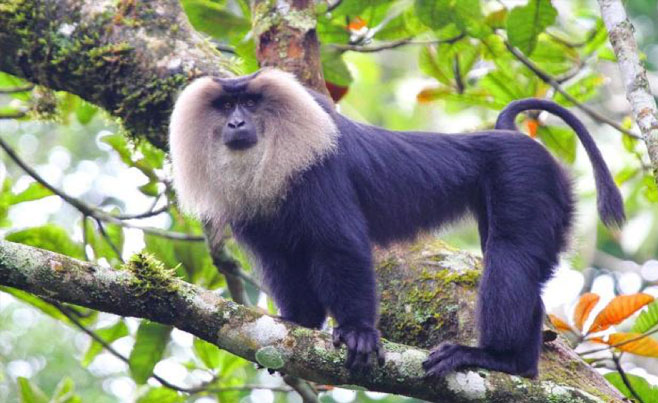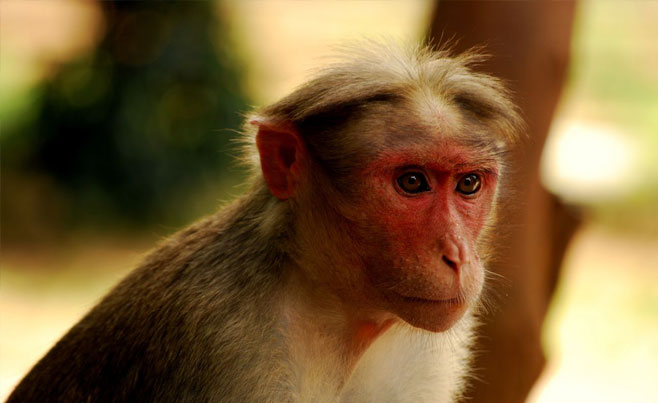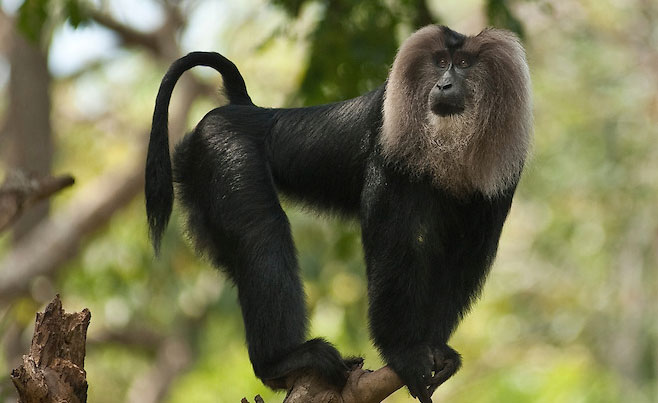Periyar National Park
Best Time To Visit
Jan
Feb
Mar
Apr
May
Jun
Jul
Aug
Sep
Oct
Nov
Dec
Most Popular
High Sighting
Park Closed
Low Sighting
About Periyar National Park
Species
Lion-tailed macaque, Bonnet macaque
Lion-tailed macaque, Bonnet macaque



Overview
An azure blue lake. Blackened tree stumps protruding from the water like an army of ancient totems. The kaei…kaei…sound of the osprey carrying across the waters. And the green forest stretching away into the hills. Periyar, situated just 10 degrees above the equator, takes your breath away with images you are unlikely to witness anywhere else in India. Situated in the Cardamom Hill Ranges of Kerala's Idukki District, south of the Western Ghats, this fabulous tiger reserve sprawls across 777 sq. km. of biodiversity-rich forests out of which 350 sq. km. are protected as core, or undisturbed wilderness. One of India's truly 'great escapes' the picturesque 26 sq. km many-fingered lake, a distinctive feature of the park that was created by the British in 1885 when they dammed the Periyar River, is a passport to the nether regions of the forest. Although more that 40 tigers hunt the forests, the chances of actually seeing one here are very low because the reclusive cat wisely prefers the more quiet interiors, away from the throb of boats and the chatter of humans. But there is probably no better place in India to watch the amazing family life of the Asiatic elephant. With plenty of food and water, these gentle giants have lived here for time immemorial. But danger now lurks around each corner. Poachers have so persistently infiltrated the forest that they have picked off almost all the truly large tuskers, which accounts for the difficulty in sighting them today. The Kerala-Tamil Nadu interstate line from Kumily in the north, the Ranni and Kakki Reserved Forests and the Kottayam Division forests defines the boundary of Periyar. Located in the Western Ghats, which are geologically believed to be among the oldest mountain chains in the world, Periyar has a most unique diversity of both terrain and vegetation. The reservoir, bounded by hills, is the central feature and is drained by the Periyar and Mullayar river systems. The Periyar River itself originates from deep within the near-virgin evergreen core area, 50 km. south of the sanctuary headquarters at Thekkady. It meets the Mullayar at Mullakudy, from where the lake starts. The river then runs on for some 244 km. before emptying into the Arabian Sea. The black stumps of old hard wood trees, some jutting out of the water and others submerged (it takes an expert boatman to avoid the stakes), are eerie reminders of a rainforest that was drowned because humans wanted abundant year-round supplies of water. Although there are 59 species of mammals in Periyar, it is the elephants that dominate the landscape and are the most visible to visitors. There are an estimated 800 pachyderms in Periyar and they live in family groups led by a matriarch. Normal sightings are of herds with young feeding, hosing themselves down with mud or water, or simply swimming along the lakeshore. Young ones never stray too far from the adults as the threat from tigers to defenceless young is very real. Used to the sound and sight of boats, the elephants carry on with their usual routine, undisturbed by camera-wielding tourists. With their ancient migratory routes cut off by the reservoir, many elephants now swim to locate favoured food sources and the sight of these huge animals, fully submerged with only their trunks visible like periscopes, is one of the more unforgettable Periyar experiences. Sadly few really large tuskers are seen today as most have been killed by poachers for the value of their ivory. Recently, even young tuskers have been picked off to get at their ivory, often less than a 100 cm. long. Clawless otters provide hours of entertainment for visitors. They swim and fish in the waters of the reservoir and can be seen bounding along the slippery, muddy shores, wet and shiny like playful pups. Low off the ground, their practice of standing on hind legs to look out for danger is an endearing habit and they are a favourite with photographers. Sounders of wild boar are easily spotted, rooting about the shores for tubers and succulent shoots. If you sit out at night near the forest rest houses, you are quite likely to see both porcupine and wild boar that come nosing around garbage dumps for something to eat. One animal that competes with the tiger for prey is the dhole, or wild dog. Though a number of tourists have reported seeing dholes, you must consider yourself particularly blessed if you return having seen these magnificent dogs. These brown, bushy-tailed canines have an exceedingly well-organised pack life and their yips and whistles reverberate across the waters of the reservoir when they are out on a community hunt. Four different types of monkeys are found in Periyar. These are the highly threatened lion-tailed macaque, the bonnet macaque, the Nilgiri langur (ask to be shown one large troupe that seems to have taken up residence near the reception area) and the common langur (more easily seen towards the eastern parts of Periyar). By and large, because macaques prefer the interiors of the tree canopy, which is barely visible from the boat, they are difficult to spot in Periyar, even though their numbers are relatively large. Pythons and cobras are animals of the deep evergreen forest. Flying (they actually only glide) lizards and snakes travel from tree to tree, the former with the aide of a flap between its extremities and the latter by flattening its body into a sail-like shape. The flying snake is a particularly beautiful reptile and is brilliantly coloured in yellow and black with crimsonish rosette-like patterns. Another aerial creature is the flying frog, which is able to glide thanks to extra webbing on its toes. The watercourses harbour at least 50 species of fish, including the golden mahseer.
An azure blue lake. Blackened tree stumps protruding from the water like an army of ancient totems. The kaei…kaei…sound of the osprey carrying across the waters. And the green forest stretching away into the hills. Periyar, situated just 10 degrees above the equator, takes your breath away with images you are unlikely to witness anywhere else in India. Situated in the Cardamom Hill Ranges of Kerala's Idukki District, south of the Western Ghats, this fabulous tiger reserve sprawls across 777 sq. km. of biodiversity-rich forests out of which 350 sq. km. are protected as core, or undisturbed wilderness. One of India's truly 'great escapes' the picturesque 26 sq. km many-fingered lake, a distinctive feature of the park that was created by the British in 1885 when they dammed the Periyar River, is a passport to the nether regions of the forest. Although more that 40 tigers hunt the forests, the chances of actually seeing one here are very low because the reclusive cat wisely prefers the more quiet interiors, away from the throb of boats and the chatter of humans. But there is probably no better place in India to watch the amazing family life of the Asiatic elephant. With plenty of food and water, these gentle giants have lived here for time immemorial. But danger now lurks around each corner. Poachers have so persistently infiltrated the forest that they have picked off almost all the truly large tuskers, which accounts for the difficulty in sighting them today. The Kerala-Tamil Nadu interstate line from Kumily in the north, the Ranni and Kakki Reserved Forests and the Kottayam Division forests defines the boundary of Periyar. Located in the Western Ghats, which are geologically believed to be among the oldest mountain chains in the world, Periyar has a most unique diversity of both terrain and vegetation. The reservoir, bounded by hills, is the central feature and is drained by the Periyar and Mullayar river systems. The Periyar River itself originates from deep within the near-virgin evergreen core area, 50 km. south of the sanctuary headquarters at Thekkady. It meets the Mullayar at Mullakudy, from where the lake starts. The river then runs on for some 244 km. before emptying into the Arabian Sea. The black stumps of old hard wood trees, some jutting out of the water and others submerged (it takes an expert boatman to avoid the stakes), are eerie reminders of a rainforest that was drowned because humans wanted abundant year-round supplies of water. Although there are 59 species of mammals in Periyar, it is the elephants that dominate the landscape and are the most visible to visitors. There are an estimated 800 pachyderms in Periyar and they live in family groups led by a matriarch. Normal sightings are of herds with young feeding, hosing themselves down with mud or water, or simply swimming along the lakeshore. Young ones never stray too far from the adults as the threat from tigers to defenceless young is very real. Used to the sound and sight of boats, the elephants carry on with their usual routine, undisturbed by camera-wielding tourists. With their ancient migratory routes cut off by the reservoir, many elephants now swim to locate favoured food sources and the sight of these huge animals, fully submerged with only their trunks visible like periscopes, is one of the more unforgettable Periyar experiences. Sadly few really large tuskers are seen today as most have been killed by poachers for the value of their ivory. Recently, even young tuskers have been picked off to get at their ivory, often less than a 100 cm. long. Clawless otters provide hours of entertainment for visitors. They swim and fish in the waters of the reservoir and can be seen bounding along the slippery, muddy shores, wet and shiny like playful pups. Low off the ground, their practice of standing on hind legs to look out for danger is an endearing habit and they are a favourite with photographers. Sounders of wild boar are easily spotted, rooting about the shores for tubers and succulent shoots. If you sit out at night near the forest rest houses, you are quite likely to see both porcupine and wild boar that come nosing around garbage dumps for something to eat. One animal that competes with the tiger for prey is the dhole, or wild dog. Though a number of tourists have reported seeing dholes, you must consider yourself particularly blessed if you return having seen these magnificent dogs. These brown, bushy-tailed canines have an exceedingly well-organised pack life and their yips and whistles reverberate across the waters of the reservoir when they are out on a community hunt. Four different types of monkeys are found in Periyar. These are the highly threatened lion-tailed macaque, the bonnet macaque, the Nilgiri langur (ask to be shown one large troupe that seems to have taken up residence near the reception area) and the common langur (more easily seen towards the eastern parts of Periyar). By and large, because macaques prefer the interiors of the tree canopy, which is barely visible from the boat, they are difficult to spot in Periyar, even though their numbers are relatively large. Pythons and cobras are animals of the deep evergreen forest. Flying (they actually only glide) lizards and snakes travel from tree to tree, the former with the aide of a flap between its extremities and the latter by flattening its body into a sail-like shape. The flying snake is a particularly beautiful reptile and is brilliantly coloured in yellow and black with crimsonish rosette-like patterns. Another aerial creature is the flying frog, which is able to glide thanks to extra webbing on its toes. The watercourses harbour at least 50 species of fish, including the golden mahseer.
Trails and Excursions
The best way to explore Periyar is by boat, but you also have the option of spending time atop watchtowers. If you are there when the Sterculia tree is in fruit, you will be presented with a feast of birdlife ranging from Mynahs to Grey Hornbills. The Nilgiri langur and the occasional sloth bear are often spotted from such well-positioned towers. Don't forget to ask for a guide to take you walking near the small patch of forest around the reception area where you might be able to photograph a troupe of Nilgiri langurs. With luck you could also see Malabar giant squirrels, barking deer, and the fruit bats called flying foxes (because of the shape of their heads) in the same area. At Eddapaliyam, right from the hotel, it is possible to sit back and enjoy the sight of gaur, elephant and wild boar as they come out to graze from inside the deep forest. Trekking is an option open only to the serious naturalist. For such visitors, the Forest Department provides guides who are local tribals. A walk into the forest with such people is an experience unto itself as you will come to learn about their customs, mores and oral tales. In very special cases, the Field Director may give you permission to boat up along the Periyar river right to the core area, where huge mahseer fish may be visible. There is a rest house here at Thanikuddi. This is typical Hornbill country. If you do get permission (by no means easy) you should look out for tiger pug marks and sloth bear scats.
How To Reach
By Air:
Madurai (145 km.) and Cochin (190 km.)
By Rail:
Kottayam (114 km.) on the Ernakulam-Thiruvananthapuram line.
By Road:
From Madurai or Cochin cars can be hired. Kottayam is the nearest major town, 115 km. to the west. Within the reserve: Diesel boats cruise the waters, enabling visitors to watch wild animals from a distance without alarming them too much. A small part of the forest is also accessible to those in search of more adventure in the way of long jungle walks. Most boats are navigated by expert pilots, and if you are lucky to get a particularly enthusiastic and talented one you will be able to approach birds and turtles quite close to their tree stump perches. You might even be able to venture inside the smaller creeks, from where the densely wooded forests are also more visible.
Tips:
Most wildlife sightings on boat rides occur early in the morning and late in the afternoon. Binoculars are essential, for most sightings from the boat are too far to really enjoy with the naked eye. Tribals are particularly good at natural history, fishing, and even collecting wild honey from hill bees, which they do at night to avoid being stung. They climb to hives atop 30 m. high trees by carving bamboo spikes into the trunk. You could try and get a guide to take you along if you are so inclined. Waterproof clothing should be carried because rain is always a possibility in a 'rainforest'. If you are walking in the deep forest especially in the heavy rains, remember the leeches. Wear boots, socks, long trousers and full-sleeved shirts. Of course, not much can stop a determined leech, but try tobacco snuff smeared on your shoes as a possible deterrent. Salt helps get them off.
Madurai (145 km.) and Cochin (190 km.)
By Rail:
Kottayam (114 km.) on the Ernakulam-Thiruvananthapuram line.
By Road:
From Madurai or Cochin cars can be hired. Kottayam is the nearest major town, 115 km. to the west. Within the reserve: Diesel boats cruise the waters, enabling visitors to watch wild animals from a distance without alarming them too much. A small part of the forest is also accessible to those in search of more adventure in the way of long jungle walks. Most boats are navigated by expert pilots, and if you are lucky to get a particularly enthusiastic and talented one you will be able to approach birds and turtles quite close to their tree stump perches. You might even be able to venture inside the smaller creeks, from where the densely wooded forests are also more visible.
Tips:
Most wildlife sightings on boat rides occur early in the morning and late in the afternoon. Binoculars are essential, for most sightings from the boat are too far to really enjoy with the naked eye. Tribals are particularly good at natural history, fishing, and even collecting wild honey from hill bees, which they do at night to avoid being stung. They climb to hives atop 30 m. high trees by carving bamboo spikes into the trunk. You could try and get a guide to take you along if you are so inclined. Waterproof clothing should be carried because rain is always a possibility in a 'rainforest'. If you are walking in the deep forest especially in the heavy rains, remember the leeches. Wear boots, socks, long trousers and full-sleeved shirts. Of course, not much can stop a determined leech, but try tobacco snuff smeared on your shoes as a possible deterrent. Salt helps get them off.
